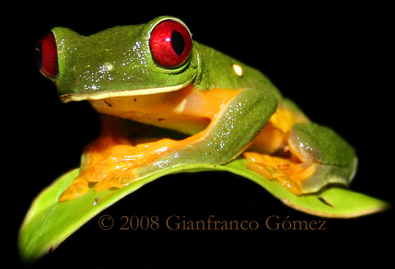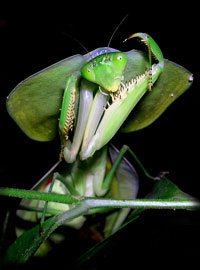|
Discover the
hidden treasures of Drake Bay, Costa Rica with Tracie "The Bug Lady"

Home

Tour
Basics

Meet the Bug
Lady

Tales from the
Edge

Media

Reservations

Links



Facts about Drake Bay, Costa Rica

Travel To Drake Bay

Drake Bay Area Map

Hotel Information

Tips for Travelers

Tours

Recommended
Reading





|
|
|
 |
|
It would
truly be an understatement to say that the Gliding Leaf Frog is a rare find
in Drake Bay. It was not
collected in Costa Rica until 1967 and until recently was only
thought to exist in the southern Pacific region of the country. They are,
however, also found on the southern Caribbean Slopes of Costa Rica.

In
nearly two decades of guiding the Night Tour, nearly every night, we
have only seen a handful Gliding Leaf Frogs.
It was a misty night in late July that we discovered our first
Gliding Leaf Frog. As we walked down the trail just past
La Paloma Lodge, the silhouette of a tree frog perched on a leaf
caught the corner of my eye. The frog was off the trail on a
leaf about two meters off the ground.
We were having a great frog
night, and I nearly passed it by thinking it was a Masked Tree Frog
(Smilisca phaeota) or a Gaudy Leaf Frog (Agalychnis
callidryas), both of which we had already seen. I decided to
have a look anyway and approached the frog, convinced it was a Gaudy
Leaf Frog the closer I got. As I took it in my hand, it surprised me
by letting out a deep, baritone "Grrrrt!". I could not believe my
eyes as I inspected the beautiful frog and realized it was a
Gliding Leaf Frog. Knowing what we had, Tracie and I were by far
the most excited people in the group that night. The frogs featured
on this page are those two wild individuals encountered in Drake Bay
during the Night Tour. |
|
Gliding Leaf Frogs are the largest members of their subfamily (Phyllomedusinae)
in Costa Rica, with adults measuring between 67 and 95 millimeters.
Frogs on the Pacific side are slightly smaller than on the Caribbean
and also differ in that their belly has an yellowish-orange
coloration. They are similar in appearance to the Gaudy Leaf Frog (Agalychnis
callidryas), to which they are closely related. At first glance,
one striking difference is their huge, highly webbed hands and feet
as well as the yellowish-orange coloration covering their hands,
feet, belly, and sides.

Their
eyes also have a much darker maroon coloration than the bright red
eyes of the Gaudy Leaf Frog.
They are strictly canopy dwellers, which explains why they are so
rarely encountered in their forest habitat. Their common name is derived
from a very peculiar mode of locomotion they employ.
When these frogs are in a hurry to get down to the ground or are
fleeing from a predator, they will freefall from their treetop
perch. As they
fall, they will spread their extensively webbed fingers and toes,
breaking their fall. Studies have shown that frogs released at a
height of 4.5 meters achieved nearly a 45 degree angle of descent
and traveled up to 4 horizontal meters during their fall! |
|
Gliding Tree Frogs are nocturnal and normally only descend to
ground level during their mating season. At this time, large
congregations of frogs gather at temporary ponds, flooded with
rainwater.
Gatherings can number into the thousands and huge numbers of frogs
are literally draped throughout the vegetation from 1.5 up to 10
meters above the water. This usually takes place during or after a
heavy rain.
Breeding starts at night, but will sometimes continue until direct
sunlight reaches the breeding area, the next morning.
A few of our friends guiding in Corcovado National Park have been
lucky enough come across these incredible scenes. To their bewilderment, entire
trees are swarming with thousands of mating frogs, their branches
bending under their weight and their leaves overwhelmed with egg
masses.
During these breeding frenzies, males greatly outnumber females and
will frequently fight amongst themselves for access to them.
Once
daylight crashes the party, the frogs disappear into the canopy just
as quickly and suddenly as they emerge. Just as we have a few
friends who have witnessed these amazing reunions, we have other
friends who have been guiding in the area for decades and have never
seen a single Gliding Tree Frog.
The egg
masses are laid on the upper surface of leaves and normally contain
between 14 and 67 eggs. They will develop on the leaf for about six
days until the tadpoles wiggle out of the egg mass and into the
water below. This will be their home for the next two to three
months until their metamorphosis is complete and the little tree
froglets leave the water to continue their lives in the forest
canopy.
Gliding Tree Frogs are only know to exist in Costa Rica, Panama
and Northwestern Ecuador. |
|
References:
Kubicki, B. 2004 Leaf-frogs of Costa Rica
Editorial INBio
Savage, J. 2002 The Amphibians and Reptiles of
Costa Rica University of Chicago Press
|

|
|
|
|
The Frog
Files





     
v





 |



 Alien Earthlings
Alien Earthlings  The
Dark Side
The
Dark Side















